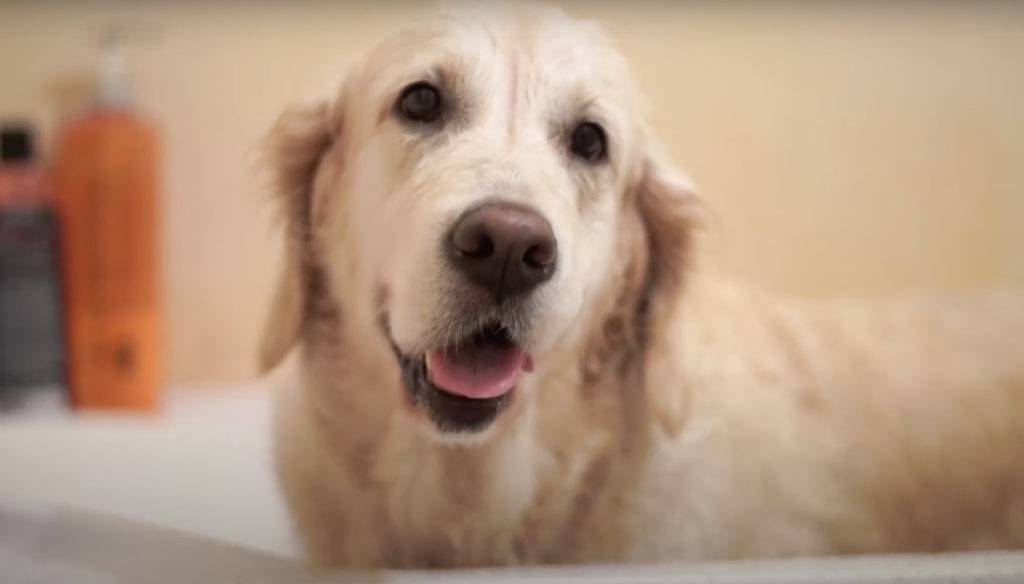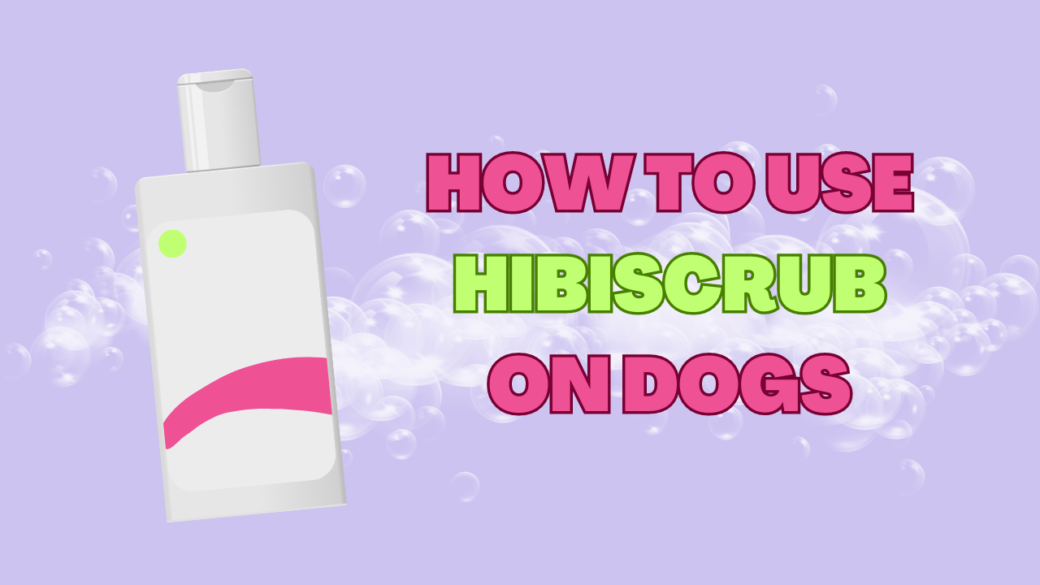HouseholdPets.co.uk is a reader-supported site, meaning if you click on any product links we recommend we may receive a small commission in return.
Sometimes, dogs can become restless and irritated by itchy skin. When this happens, they can bite and scratch their skin raw; for dog owners as well as their pets, this can be a distressing experience. Thankfully, there are specific treatments available to ease itchiness and discomfort.
Hibiscrub is an antiseptic wash commonly used in hospitals and veterinary practices, and it has been used for decades, which means this product is safe to use on humans and animals. It can be bought online, as shown below:

This product is often used to clean wounds and treat dogs’ itchy skin; when dogs scratch, they can sometimes tear their skin, which can lead to infections and severe irritation. Hibiscrub soothes itchiness and helps to stop infections.
To ensure dog owners understand how to use Hibiscrub on dogs, they must first know what the product is and the best ways to use it safely.
Table of Contents
What is Hibiscrub?
Hibiscrub is a red, clear liquid antibacterial wash that vets use in professional settings and pet owners at home. It contains the active ingredient chlorhexidine gluconate; this is a disinfectant and antiseptic often used to sterilise skin before and after surgery as well as surgical equipment. Chlorhexidine gluconate is also used as a mouthwash to treat gingivitis.
As a concentrated solution, Hibiscrub is a powerful disinfectant. It is effective against most bacteria, viruses, yeasts, and some fungi.
When used on dogs, Hibiscrub is used primarily to treat skin problems and prevent infection.
Is Hibiscrub Safe to Use on Dogs?
Yes, Hibiscrub is generally safe for external use on most dogs. However, this can depend on how it is used on dogs; there are some ways Hibiscrub should not be used to avoid harming the animal.
Although Hibiscrub is available to buy in shops as an over-the-counter product, dog owners are advised to seek veterinary advice before using it on their dogs. The vet will be able to give you advice on what the best treatment is for your dog’s skin condition and how to apply Hibiscrub to your dog’s skin.
What Skin Conditions Can Hibiscrub Treat?
If your dog suffers from certain skin conditions listed, then the vet might advise you to use Hibiscrub for treating:
- Hot spots
- Yeast infections
- Ringworm
- Pyoderma

It’s also a good treatment for itchy or dry skin.
How Can You Use Hibiscrub on Dogs?
Now you know Hibiscrub is safe to use on dogs, it is time to learn how to use it safely. There is more to it than just opening the bottle and pouring the solution on the dog’s coat; in fact, doing this could irritate their skin even further. You must read the instructions on the back of the packaging and receive vet advice on its suitability before using this product on your dog.
Before you begin washing your dog, you must first dilute the Hibiscrub in fresh water to reduce the strength of the solution before using it. The correct dilution rate for Hibiscrub for topical use is one part Hibiscrub to ten parts warm water. Diluted Hibiscrub should not change the colour of the water; the red colour of the liquid should mix with the water to create a clear solution.
You can use Hibiscrub to bathe your dog using a warm flannel, clean cloth, or sponge; this will help to prevent the dog’s skin from drying out. You can also use Hibiscrub in an ear wash to treat external otitis (outer ear infection) as well as ear mites.
After you have applied Hibiscrub, allow your dog to be in contact with the solution for the required amount of time – see the advice of your vet or the instructions on the bottle before use. The mixture should have worked to a foam on the dog’s fur and skin. This foam aids in preventing infections from developing and can be left on the skin for up to five minutes in most cases. It also helps to kill bacteria.
It is important to note that you should not allow Hibiscrub to enter your dog’s eyes, ears, or mouth. Hibiscrub also should not touch open wounds on the dog’s body. After you have finished using the solution on your dog, make sure to rinse the antisceptic solution away wholly. This will help the skin’s proper healing process take place.
Can You Give Dogs’ Hibiscrub Orally?
Although some pet care websites state that Hibiscrub can be used to treat oral infections, this is not the case. Hibiscrub should not be given to dogs orally. When it is used, it is essential to avoid contact with the dog’s mouth as well as its eyes, ears, and any open wounds it may have.
If you suspect your dog has ingested Hibiscrub, contact your veterinary practice as soon as possible. They will be able to recommend products for oral care.
Can You Use Hibiscrub on Dogs’ Open Wounds?
Hibiscrub should not be used if your dog has an open wound; this is not what it was designed for. This disinfectant might be too harsh for wounds and could delay healing from taking place. It could also stop scabs from forming.
There are other products available that can help in healing a dog’s open wounds.
Can You Use Hibiscrub on Dogs’ Tick Bites?
Hibiscrub can be used on tick bites. It can help to reduce the risk of infection in the open wound left behind from the tick bite.
After correctly removing the tick from a dog’s skin using a tick hook tool, the bite should be bathed in salt water or an antiseptic solution, like Hibiscrub. The tick bite should be bathed daily for three to five days after the tick has been removed.
Can You Use Hibiscrub on Dogs’ Itchy Skin?
If your dog suffers from itchy skin all over their body, Hibiscrub can be used to soothe the irritation. The best way to use Hibiscrub for a full-body itch is to bathe your dog in a mixed solution. To do this, there are specific instructions to follow.
Firstly, you must wash your hands and fill a tub or bath with a mix of Hibiscrub and warm water. The best mixture is one part Hibiscrub to ten parts water; this measurement might differ depending on vet advice. Once the dog is in the bath or tub, use a jug to wet all its skin and fur with the Hibiscrub-water mix. While your dog’s coat is still wet, use your hands or a soft cloth to lather the solution into the skin.
To get the most benefit from this treatment, leave the lather on the skin for five minutes before thoroughly rinsing it off with clean water. Repeat the rinsing until the Hibiscrub solution is washed away. Afterward, gently towel dry your pet’s skin and brush off any excess hair and dead skin.
Do not use Hibiscrub on body wounds, eyes, ears, nose, or mouth.

Will Hibiscrub Stop Dogs’ Skin from Itching?
Hibiscrub is a good treatment for a dog’s itchy skin temporarily. If a dog experience itchiness regularly, then visiting a vet should help find the underlying cause; it could be an allergy or hay fever, and the dog might require an antihistamine. For more information on antihistamines for dogs, read this article.
It is advised not to use Hibiscrub too frequently as it can cause a dog’s skin to dry out, which might lead to an increase in itchiness and discomfort.
How to Use Hibiscrub on Patches of Itchy Skin
Pet owners can also use Hibiscrub for dogs to treat patches of itchy skin, although this will not require the dog to be bathed in the solution. The solution of water and Hibiscrub (again, one part Hibiscrub and ten parts water) will be easier as a topical treatment.
This solution can be rubbed into the areas that suffer from itchiness until a foam has formed. Just like with the full body wash, leave the foam on the dog’s fur and skin for up to five minutes to ensure it works correctly. Then, the treatment can be rinsed away completely.
After the mixture has been washed off, use a clean towel or sterile gauze to pat dry the affected area.
Can You Use Hibiscrib on Dogs’ Eyes?
This product should never be used on or near a dog’s eyes. It does not matter if the liquid has been diluted, which it always should be when used on dogs. The eyes are vulnerable to chemicals, meaning Hibiscrub could potentially cause visual impairments, such as eye ulcers.
As Hibiscrub is not designed for treating eye problems, a vet should be contacted immediately if the solution comes into contact with your dog’s eyes.
Can You Use Hibiscrub on Dogs’ Ears?
A dog’s ears are sensitive, especially the inner ear. Hibiscrub for dogs should only be used externally; it can be used on the outside of a dog’s ears, but it should never have contact with the inside. This could cause complications in the ear canal.
If your dog suffers from itchiness on the inside of their ears, a vet should be consulted to see which products are suitable.
Can You Use Hibiscrub to Treat a Dog’s Yeast Infection?
Hibiscrub for dogs can be used to treat a yeast infection, whether on a dog’s paws or its entire body. However, it is recommended that you seek the advice of a veterinarian before doing so.
A veterinarian must diagnose the yeast infection, and then you will be given an appropriate treatment plan. Your vet may also recommend an antifungal medication or shampoo in addition to Hidiscrub.
Does Hibiscrub for Dogs Have Side Effects?
If your dog suffers from sensitive skin, then there are some common side effects of using Hibiscrub that they might experience.
What Side Effects Does Hibiscrub Cause for Dogs?
The following side effects can be experienced if your dog has sensitive skin and Hibiscrub is used:
- Burning sensation
- Rashes
- Discomfort
- Redness
- Blisters
- Skin inflammation
If your dog does develop any of these adverse reactions, stop using Hibiscrub straight away.
How to Use Hibiscrub on Dogs: FAQs
As it is important to use Hibiscrub safely, you should be fully aware of how to do so. These frequently asked questions can better prepare dog owners before they use the solution on their dogs.
How Much Hibiscrub Should Be Used on Dogs?
Only a small amount of Hibiscrub should be used when treating dogs. The most commonly recommended amount is a dilution of one part Hibiscrub to ten parts water.
Do You Need to Dilute Hibiscrub Before Use?
Diluting Hibiscrub for dogs is essential; the diluted solution is easier on dogs’ skin and less likely to cause additional skin problems. For mild irritations, one part Hibiscrub to ten parts water is recommended.
Undiluted Hibiscrub could potentially cause further irritation to the affected area, so you should not allow the undiluted solution to come into contact with your dog’s skin.
Do You Need to Wash Hibiscrub Off of Dogs?
Hibiscrub does need to be rinsed off after being used. This product can irritate and even burn the dog’s skin if left on for too long; five minutes is the maximum Hibiscrub should be left on before washing the solution off.
How Often Should You Use Hibiscrub on Dogs?
Depending on the severity of the dog’s skin condition, Hibiscrub might need to be used multiple times a day. If this is the case, ensure to use it at the same times each day.
It might take several weeks before improvements are seen on your dog’s itchy skin. However, dog owners should look out for the previously mentioned side effects; if any side effects are experienced, stop using this treatment. If used too frequently, Hibiscrub can kill good bacteria on the dog’s skin.
Can You Use Cold Water with Hibiscrub?
Cold water should be avoided when using Hibiscrub for dogs; it can irritate the skin when rinsing away the solution. Warm water should be used instead.
To Sum Up
Although this product is suitable for treating certain skin conditions, it is not completely safe. Hibiscrub is for external use only. The diluted solution should be used and should never come into contact with the dog’s eyes, ears, nose, and mouth. Additionally, Hibiscrub should not be used on a dog’s open wounds.
For any skin condition, a veterinarian should be consulted before you read the label on Hibiscrub and misuse it on your dog. As a pet owner, you can get assistance from your vets on how to use the product to help your dog.
It is always better to take the time to contact a vet for advice before using a product incorrectly, especially when that product can cause your pet further harm.
Disclaimer: This article is for informational purposes only and should not be used as a substitute for professional veterinary advice.

